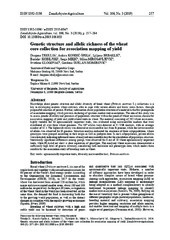Prikaz osnovnih podataka o dokumentu
Genetic structure and allelic richness of the wheat core collection for association mapping of yield
| dc.creator | Trkulja, Dragana | |
| dc.creator | Kondić-Špika, Ankica | |
| dc.creator | Brbaklić, Ljiljana | |
| dc.creator | Kobiljski, Borislav | |
| dc.creator | Mikić, Sanja | |
| dc.creator | Mirosavljević, Milan | |
| dc.creator | Glogovac, Svetlana | |
| dc.creator | Šurlan-Momirović, Gordana | |
| dc.date.accessioned | 2021-04-26T19:43:39Z | |
| dc.date.available | 2021-04-26T19:43:39Z | |
| dc.date.issued | 2019 | |
| dc.identifier.issn | 1392-3196 | |
| dc.identifier.uri | http://fiver.ifvcns.rs/handle/123456789/1849 | |
| dc.description.abstract | Knowledge about genetic structure and allelic diversity of bread wheat (Triticum aestivum L.) collections is a key to developing modem wheat cultivars, able to cope with various abiotic and biotic stress factors, through purposeful selection of parents. Further, information about population structure of a material is the first prerequisite of association mapping, which prevents declaring of spurious marker-trait associations. The aim of this study was to assess genetic diversity and presence of population structure within the panel of wheat accessions chosen for association mapping of yield and yield related traits in wheat. The material consisting of 282 wheat accessions, highly variable for 10 agronomically important traits, was evaluated using microsatellite markers that were distributed all over three wheat genomes. The 397 alleles were detected at 31 SSR markers, with an average number of 12.4. The highest diversity was detected at microsatellite loci from B genome, while the lowest number of alleles was observed for D genome. Structure analysis indicated the existence of three subpopulations, where genotypes were grouped according to their origin as well as pedigree data. In each subpopulation, private alleles were detected, indicating informativeness of analysed microsatellite loci for the elucidation of population structure. Statistically significant differences among groups were observed for 8 out of 10 wheat agronomically important traits, while PCA did not show a clear separation of genotypes. The analysed wheat accessions demonstrated a sufficiently high level of genetic diversity, considering both molecular and phenotypic data, which makes them suitable for the association study of breeding traits in wheat. | en |
| dc.publisher | Lithuanian Research Centre Agriculture & Forestry, Kedainiu R | |
| dc.relation | info:eu-repo/grantAgreement/MESTD/Technological Development (TD or TR)/31066/RS// | |
| dc.rights | openAccess | |
| dc.rights.uri | https://creativecommons.org/licenses/by-nc-nd/4.0/ | |
| dc.source | Zemdirbyste-Agriculture | |
| dc.subject | agronomically important traits | en |
| dc.subject | diversity | en |
| dc.subject | microsatellite loci | en |
| dc.subject | Triticum aestivum | en |
| dc.title | Genetic structure and allelic richness of the wheat core collection for association mapping of yield | en |
| dc.type | article | |
| dc.rights.license | BY-NC-ND | |
| dc.citation.epage | 264 | |
| dc.citation.issue | 3 | |
| dc.citation.other | 106(3): 257-264 | |
| dc.citation.rank | M23 | |
| dc.citation.spage | 257 | |
| dc.citation.volume | 106 | |
| dc.identifier.doi | 10.13080/z-a.2019.106.033 | |
| dc.identifier.fulltext | http://fiver.ifvcns.rs/bitstream/id/772/1846.pdf | |
| dc.identifier.scopus | 2-s2.0-85071436322 | |
| dc.identifier.wos | 000480418800009 | |
| dc.type.version | publishedVersion |


